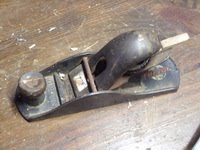Third Class....lowest class was simply to "rough" cut a piece of wood to general dimensions.
Cuts were made at a 45 degree angle.
Second Class.... Cutting a tenon...mark the wood with a gauge... with a chisel(with the bevel facing toward the waste side) make a nick on the end corner, then pare down a small wedge toward the tenon. Next begin sawing with a smaller tooth hand saw at a 45 degree angle slightly, then saw approx 1/8 of an inch down along the length of the cut. Then cut at a 45 degree angle on one side of the tenon, following the 1/8 inch groove cut. Next turn the work around and finish the cut.
First Class...... this is a saw cut that will be visible on the workpiece. The Shoulder cut is an example of a first class cut. After scoring the piece with a marking guage, then using a large chisel, push down slightly on the scored line with the bevel facing the waste side, next pare down a very small wedge making a small groove for the saw to follow finishing the shoulder cut.
Tuesday, February 1, 2011
Sloyd Method
Was watching the Woodwright Shop on PBS and learned of a woodworker named Otto Salomon who employed the Sloyd Method of working wood. He insisted that a teacher never....ever touch the students work. The "Here..let met show you..method" just didn't work for him. He believed that a student must work hard to achieve a standard on his own, coaching with words were ok... but nothing was to be done by the teacher on the project. The Sloyd method of teaching is very interesting. I'll read more and get back to making an updated entry.
Tuesday, April 20, 2010
Another Mans Trash.....
 Is another Mans Treasure. I wonder if I can bring this old boy back to life! Imagine...A dollar and seventy five cents. Notice the clothes pin!
Is another Mans Treasure. I wonder if I can bring this old boy back to life! Imagine...A dollar and seventy five cents. Notice the clothes pin!I'd like to research the manufacturer, although I'm fairly sure that it is Fulton.
Fulton was the "house brand" for the United Hardware and Tool Manufacturing Company, a hardware wholesaler, but is probably best known as an early tool brand sold by Sears Roebuck. In the pre-Craftsman days, Fulton appeared to be the most popular tool brand offered by Sears, and even after Craftsman had become well established, Sears continued to carry Fulton tools as lower-cost alternatives.
Fulton tools were likely made for United Hardware by a contract manufacturer, and the great similarity between some Fulton and Craftsman tools suggests that the same manufacturer later produced tools for Sears.
http://www.tias.com/8600/PictPage/3923468803.html this is a link to an antique tool site listing a similar but smaller Fulton Block plane.
G. Michael
Monday, April 19, 2010
The Wish List

For now, I will just write down everything that comes to mind and then prepare a plan of action.
1. Eventually open a shop called, "The Splinters Edge" A lot of work to do!
2. Book and magazine swap meet.
3. Skill seminars.
4. Develop planning goals for growth.
5. Look into feasibility of Not for profit vs. Non Profit status for the purpose of securing grants.
6. Fund raising.
7. Shop/meeting location.
8. Membership requirements/Cost analysis.
9. Insurance
10. Setting up shop - see 1870 shop.
11. Wood and Tool Swap.
to be continued and edited.......
G. Michael
The Blue Print

Every new endeavor must first have a plan. Today, I will select a name and prepare a draft mission statement.
The Splinters Edge
What can I say... the name just popped into my head and..... I really like it!
Mission Statement
"The Mission of the Splinters Edge is to form a society of individuals who possess a passion for working with wood. The members must develop a passion for developing the skill sets of old that have been lost and to pass them along to the next generation."
G.Michael
What can I say... the name just popped into my head and..... I really like it!
Mission Statement
"The Mission of the Splinters Edge is to form a society of individuals who possess a passion for working with wood. The members must develop a passion for developing the skill sets of old that have been lost and to pass them along to the next generation."
G.Michael
Subscribe to:
Posts (Atom)

